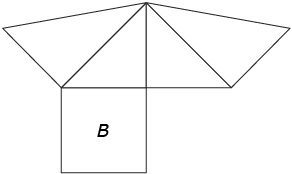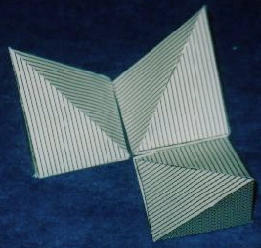Lesson 3
1. Lesson 3
1.4. Discover
Module 7: Volume and Capacity
Discover
In this section you will investigate the relationship between the volume of a rectangular prism and the volume of another pyramid with the same base and height.
Try This 1

© Cathi Sanders and The Math Forum at Drexel University. Reproduced with permission.

© Cathi Sanders and The Math Forum at Drexel University. Reproduced with permission.
Step 1: Print off three copies of Pyramid Net on paper or cardstock.
Step 2: Cut out each net, fold along the lines, and then tape to form three identical pyramids, each with base B.
Step 3: Arrange the three pyramids so they fit together to form a rectangular prism. You may wish to use small pieces of tape to join the three pyramids together so that you can open and close the object.
Hint
Watch “How to Split a Cube Into 3 Identical Pyramids.”
- Use a ruler to measure the length and width of the base of the rectangular prism to the nearest tenth of a centimetre. Calculate the area of the base in square centimetres.
- Using the ruler, measure the height of the rectangular prism to the nearest tenth of a centimetre. Calculate the volume of space the prism takes up in cubic centimetres.
- From the volume of the rectangular prism, how could you find the volume of each pyramid? Calculate the volume of each pyramid.
- Use the results from questions 2 and 3 to determine a formula for finding the volume of each pyramid.
- What kind of rectangular prism did you form? How do you know?
Share 1
Share your responses to the questions in Try This 1 with a partner or with a group of people.
- Compare the formula you developed in question 4 with your partner’s formula. Describe any similarities and differences that may exist.
